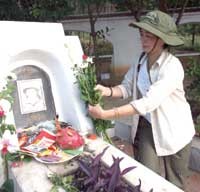Saluting the girls of Dong Loc Junction

Startled, Sac opened his notebook to check the company he photographed. The group, A4-C552, was the same that had been bombed.
Hero worship: Everyday, people from across the country come to burn incense and worship the 10 girls who died at the junction.
"They were very lively. Some even cheekily sat on the table when I and their company chief were talking. Despite the hardships, they had beautiful faces. I asked them: ‘Do you fear death?’ They said ‘yes’ but were happy to die for the country’s independence and unification."
Like thousands of young volunteers across the country who died during the American War, the women, aged 17 to 20 and led by Vo Thi Tan, were assigned a crucial task.
The junction was an important place on the Viet Minh’s North to South supply line – each supply truck carrying army men, food, arms and munitions passed this junction – and US aircraft heavily bombarded the 50-ha area.
Despite repeated bombings, the young volunteers, including A4-C552, stayed at their posts, using only shovels and hoes to level bomb craters.
Volunteers were usually barred from the junction in daytime because of the thread of enemy reconnaissance planes.
Hero worship: Everyday, people from across the country come to burn incense and worship the 10 girls who died at the junction.
Volunteers lived in local people’s homes and worked at night. Sometimes, the road levelling was not finished before the trucks came so the volunteers had to wear bright shirts and guide trucks around the bomb craters. 
Legend has it that on July 24, A4-C552 received an order to level the road in preparation for a special convoy which was coming that night.
It was half past three and the girls went out to the junction, which was riddled with debris. Not long after, a
However, the aircraft suddenly came back and started bombing. The girls had nowhere to run so they crept into a bomb shelter in the side of a hill. About 60 high-explosive bombs crashed down on the intersection and one exploded right in front of the shelter where the girls were hiding. The door to the shelter was covered under tonnes of earth and rock. It was 4pm.
Nine bodies were eventually unearthed, one by one.
But a girl named Ho Thi Cuc was nowhere to be found. Her comrades dug deep into the ground – at one point getting a bulldozer – but to no avail.
On the third day, Cuc was finally found. She was 20m away from her sisters, sitting with a conical hat on her head, a hoe nearby. Her fingertips were covered in scratches from a mad attempt to escape her tomb of soil.
The girls were buried near the place where they died. Everyday, people from across the country still come to burn incense and worship them. A monument engraved with the names of the heroines was erected on a hill at Dong Loc Junction.
According to locals, because the girls died young, their souls are sacred and have they supernatural powers, including the ability to bless worshippers.
Under siege After National Highway No 1 was destroyed by the US, the Dong Loc intersection in the central province of Ha Tinh become the main junction connecting National Highway No 15 with Truong Son Trail, the trans-Viet Nam North-South supply line. For that reason, the The girls of Dong Loc are 10 of the 19,800 volunteers and army men who died in safeguarding the Truong Son Trail during the American War. About 40,000 others returned home with injuries. A film based on the 10 girls, Dong Loc Junction, was released in 1997 by director Luu Trong Ninh. It won the Gold Lotus Prize at the 12th Vietnamese Film Festival in 1999. Organisations and individuals nationwide have donated VND1.5 billion for the contruction of a bell tower in commemoration of soldiers who died at the site. Construction started on July 15
Survivors
Amid the carnage, two members of the company managed to survive. one was Nguyen Thi Huong.
" After an order from my superiors, I left A4-C552 for the Vinh Linh frontline in
"Our chief Vo Thi Tan, the oldest, held my hand and advised me to be careful. Everybody worried because I was just 17 years old and the youngest.
"When I heard my comrades had been killed, I burst out crying. My new comrades consoled me and said the best thing I could do for my sisters was to brush away my tears, get stronger and avenge them by fighting the enemy. For years, I did that." Huong said crying.
"We came from different backgrounds. Some were from full families like me, Nguyen Thi Xuan and Vo Thi Tan but some others including Ho Thi Cuc, Nguyen Thi Nho and Tran Thi Huong were orphans. However, all of us offered ourselves to the fatherland with our patriotism, love for Vietnamese people and the ideals of national liberation and unification.
Now, Huong is happily married to an army man and has three grown children. Her family earn a living by growing fruit trees and breeding pigs and poultry. Her life is peaceful.
Van Sac recently went to a memorial service at Dong Loc junction hoping to see the survivors of company A4-C552, but left disappointed. That night, Huong was only a few metres away visiting the tombs of her fallen comrades while he taking part in an official ceremony.
Huong remembers someone took her picture 30 years ago, but she has never seen it. Sac, though, got her phone number setting the stage for a possible reunion.







